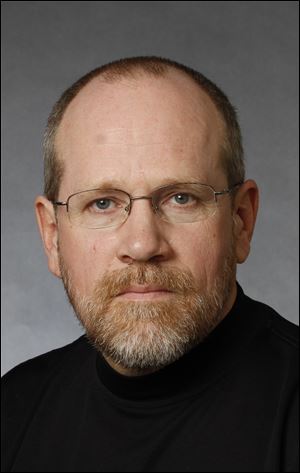
OUTDOORS
Explorer offers insight into Fitzgerald sinking
10/25/2013
Matt Markey
To commemorate the Edmund Fitzgerald, the Toledo Yacht Club will host a program entitled “The Final Voyage” on Nov. 10, the 38th anniversary of the loss of that freighter in a Lake Superior storm that had produced hurricane force winds.
There will be a 3-D presentation by Frederick J. Shannon, a renowned Great Lakes shipwreck explorer who studied and photographed the wreckage of the Edmund Fitzgerald up close while making seven trips to the location in a research submarine.
After several prior expeditions to the site by other entities had failed to provide many answers as to the cause of the disaster, in 1994 Shannon took on the project and located the vessel lying on the bottom of the lake in 530 feet of water.
He brought back haunting images of the Edmund Fitzgerald, illustrating how the mighty ship had literally been broken in half by the storm.
The Edmund Fitzgerald was a 729 foot ore carrier that had left the docks in Superior, Wis., late in the afternoon of Nov. 9, 1975, loaded down with 26,116 tons of iron ore pellets. The ship was led by Capt. Ernest M. McSorley, who was born in Canada but at the time of the fateful voyage lived in the Toledo area. The Edmund Fitzgerald was headed for Zug Island, near Detroit.
As a storm brewed out on the lake, Capt. McSorely took a northern track across Superior, hoping to get some protection from the higher elevations on the Canadian shoreline. He passed between Isle Royale and the Keweenaw Peninsula, and then turned southeast toward Whitefish Point.
The weather worsened, and by the next morning the wind was gusting to 50 knots (58 mph) and churning up seas 16 feet high. As the waves battered the Edmund Fitzgerald, McSorely radioed to a nearby ship, the Anderson, that his vessel was taking on water and listing, but that he had the pumps working to remove the water.
By early evening, the ship trailing the Fitzgerald reported wind gusts to 70 knots (81 mph) and 25 foot waves. About 7 p.m., the Anderson was hit by two huge waves that then were headed toward the Fitzgerald, 10 miles ahead.
The Edmund Fitzgerald disappeared from radar a short time later. There were no distress calls from the Fitzgerald, and radio transmissions to the ship went unanswered. In dreadful conditions, the Anderson searched for the missing ship, but found only two of the Fitzgerald's lifeboats, but no survivors.
All 29 men aboard the Edmund Fitzgerald perished. At least a half-dozen of the crewmen aboard the Edmund Fitzgerald were from the Toledo area.
“This tragedy has that strong connection to Toledo, and that was one of the reasons we felt it was very important to bring this program here,” said Sue Hurst, manager of the Toledo Yacht Club.
For his presentation at TYC, Shannon will be joined by Jon Soyring, the nephew of Oliver J. Champeau, one of the engineers aboard the Fitzgerald.
The TYC event begins with a cocktail hour from 4:30 to 5:30 p.m., followed by dinner. Shannon’s presentation begins at 7 p.m. A Great Lakes freighter style dinner will be served, and followed by a roll call of the names of the lost sailors, accompanied by a tolling of the bell.
Advance tickets and reservations are required. Contact TYC at 419-723-3485 for tickets and additional information.
YOUNG BIRDERS EVENT: Black Swamp Bird Observatory will hold the 7th Annual Ohio Young Birders Conference on Nov. 2 at the Toledo Zoo. The presentations are done by the 18-and-under crowd, but the event is open to everyone. Along with the student presentations, this event includes a morning of behind the scenes tours of the zoo’s aviary and herpetology exhibits. The day includes lunch, raffles, and a bird quiz led by expert birder and author Kenn Kaufman.
FISHING REPORT: Algae and weather are the limiting factors anglers are facing as they try to take advantage of any decent day to get out on Lake Erie. Walleye pro Ross Robertson reports the fall bite is beginning to kick in as the temperatures drop and walleye migrate back to the areas around the islands. Trolling continues to be a proven method for landing fall walleye, with anglers using both worm harnesses and crank baits behind planer boards. The yellow perch fishing has been decent when the wind has given anglers a comfortable window to get out to the traditional locations. The ODNR reports perch catches have been good around West Sister Island, near the north end of the Toledo shipping channel, nine miles out from the Toledo water intake, on West Reef, west of Green and Rattlesnake islands, between Kelleys Island and Lakeside, northwest of Kelleys Island, and off Kelleys Island Shoal. The proven approach is fishing shiners near the bottom with spreaders. There have been reports of steelhead trout being caught off the piers in Fairport Harbor, and in the Grand River, up to Helen Hazen Wyman Park. Anglers are picking up steelhead by fishing jigs tipped with maggots or minnows, or using small spoons.
Contact Blade outdoors editor Matt Markey at: mmarkey@theblade.com or 419-724-6068.